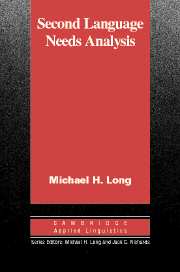Book contents
- Frontmatter
- Contents
- List of contributors
- Acknowledgments
- Overview: A rationale for needs analysis and needs analysis research
- I Methodological issues
- II The public sector
- III The occupational sector
- Chapter 4 Sources, methods and triangulation in needs analysis: A critical perspective in a case study of Waikiki hotel maids
- Chapter 5 Foreign language need of business firms
- Chapter 6 Evaluating the use of multiple sources and methods in needs analysis: A case study of journalists in the Autonomous Community of Catalonia (Spain)
- Chapter 7 “Feet speak louder than the tongue”: A preliminary analysis of language provisions for foreign professional footballers in the Netherlands
- IV The academic sector
- V Analyzing target discourse
- Index
Chapter 4 - Sources, methods and triangulation in needs analysis: A critical perspective in a case study of Waikiki hotel maids
Published online by Cambridge University Press: 25 January 2010
- Frontmatter
- Contents
- List of contributors
- Acknowledgments
- Overview: A rationale for needs analysis and needs analysis research
- I Methodological issues
- II The public sector
- III The occupational sector
- Chapter 4 Sources, methods and triangulation in needs analysis: A critical perspective in a case study of Waikiki hotel maids
- Chapter 5 Foreign language need of business firms
- Chapter 6 Evaluating the use of multiple sources and methods in needs analysis: A case study of journalists in the Autonomous Community of Catalonia (Spain)
- Chapter 7 “Feet speak louder than the tongue”: A preliminary analysis of language provisions for foreign professional footballers in the Netherlands
- IV The academic sector
- V Analyzing target discourse
- Index
Summary
Introduction
Several researchers have pointed to the inadequacy of outsiders' intuitions and the value of insiders' perspectives in needs analysis (NA), curriculum development and materials design for language teaching, as well as the importance of using multiple sources and methods (Long, this volume; Ramani et al, 1988; L. West, 1984; R. West, 1994). Few published studies on NA, however, have utilized multiple sources and methods, and of those that have (e.g., Cumaranatunge, 1988), fewer still have utilized triangulation. The purpose of this chapter is two-fold: (i) to compare several methods and sources available to needs analysts; and (ii) to report findings of a study of the needs of hotel maids which used multiple sources and methods, and triangulation.
NA and social engineering
Recently, a great deal of emphasis has been placed on NA for occupation-specific VESL (Vocational English as a Second Language) and other ESP (English for Specific Purposes) courses, often motivated by pressing time constraints, limited financial resources, and institutional and learner expectations (Chambers, 1980; Cumaranatunge, 1988; L. West, 1984). Institutional VESL and ESP curricula, however, face strong criticism from critical educators. Auerbach (1995) questions NA for the workplace as the basis for curriculum development for ESL students altogether, arguing that the process is often performed by outsiders whose information comes from institutions with clearly defined expectations of what they want the workers/students to do. Such information, she argues, can only be transformed into a curriculum whose goals are to serve the interests of institutions which have traditionally marginalized ESL speakers, socializing them into passive acceptance of subservient roles.
Information
- Type
- Chapter
- Information
- Second Language Needs Analysis , pp. 127 - 158Publisher: Cambridge University PressPrint publication year: 2005
Accessibility standard: Unknown
Why this information is here
This section outlines the accessibility features of this content - including support for screen readers, full keyboard navigation and high-contrast display options. This may not be relevant for you.Accessibility Information
- 27
- Cited by
